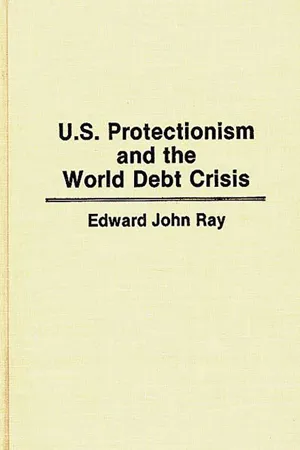Geography
Debt Crisis
A debt crisis refers to a situation where a government, corporation, or country is unable to meet its financial obligations, often resulting in default or the need for a bailout. This can lead to economic instability, currency devaluation, and social unrest. Debt crises can have significant geographical implications, impacting trade, investment, and development within and across regions.
Written by Perlego with AI-assistance
Related key terms
1 of 5
3 Key excerpts on "Debt Crisis"
- No longer available |Learn more
Trade and Development Report 2011
Post-crisis Policy Challenges in the World Economy
- (Author)
- 2012(Publication Date)
- United Nations Publications(Publisher)
The contribution of non-fiscal factors to debt crises “Financial crisis” is a broad term that encom- passes many types of crises. A public Debt Crisis occurs when a government is unable to fully com- ply with its debt service obligations vis-à-vis either domestic or external creditors. Such a crisis is thus associated with budgetary imbalances that have become unsustainable. An external debt cri- sis originates from a country’s overall inability to service its debt owed to external creditors. It is therefore associated with an external transfer prob- lem (Keynes, 1929). This may reflect either private or public domestic imbalances. A currency crisis is characterized by a sudden drop in the value of the domestic currency, well below a level justified by the country’s macroeconomic fundamentals. It is usually triggered by perceptions and market expectations that affect capital movements. Finally, a banking crisis happens when a significant segment of a country’s banking sector is either insolvent or is subject to a generalized panic. 8 While the focus of this section is on public-debt crises, these different types of crises are closely related to each other: one type of crisis often is the cause of the other. Indeed, the other types of crises may interact with, and actually lead to public debt crises. Debt crises – including public-debt crises – do not always have a fiscal origin. In order to gain a bet- ter understanding of this issue, it is worth reviewing some important, albeit abstruse, accounting definitions. A good starting point for discussing the origin of debt crises and the view that debt crises always originate from excessive budget deficits, is the basic public debt accumu- lation equation. According to this equation, the change in the stock of public debt is equal to the deficit accumulated during the period under consideration, represented as follows: Debt t+1 – Debt t = Deficit t . - eBook - PDF
- Edward Ray(Author)
- 1989(Publication Date)
- Praeger(Publisher)
Media coverage of the international debt problem facing developing countries has diminished over time but not because the problem is much less serious today than when it first commanded headlines. Dealing with the Debt One of the ongoing methods for dealing with the debt problem that is intended to avoid an international financial crisis has been to bring Figure 16 Ratio of External Debt to GDP, 1977-1986 Major Market Borrowers — Wide Solid Line Indebted Developing Countries — Long Dashed Line Countries With Recent Debt Servicing Problems — Broken Line SOURCE: Adapted from numerical data in IMF, World Economic Outlook, April 1985, Washington, D.C., Table 48, pp. 2 6 6 - 6 7 . 122 U.S. PROTECTIONISM AND THE WORLD Debt Crisis borrowers and lenders together in the hope that they could work out a revised schedule of payments. While national governments and inter- national agencies have encouraged those efforts, the parties involved have had plenty of incentive of their own to pursue the possibility of resched- uling debts. John Maynard Keynes is reported to have observed once that if you owe a bank $1, the bank owns you, but if you owe a bank $1 million, you own the bank. In effect, if you are an important borrower for a bank, the bank's financial success or failure becomes bound up in your success or failure in meeting your loan obligations. Once it is clear to the bank that its own financial survival is tied to your ability to continue to pay your debts, the bank has a strong incentive to try to help you develop a manageable payment schedule. While the sums involved are much greater, that is exactly the kind of action that banks have taken with respect to managing the external debt of the major market borrowers. Table 7 summarizes the amount of rescheduling that occurred between 1983 and 1986. As indicated, much of the debt rescheduling that has taken place has involved the major market debtor countries that we are focusing on in this study. - eBook - PDF
- Andrew Leyshon, Roger Lee, Linda McDowell, Peter Sunley, Andrew Leyshon, Roger Lee, Linda McDowell, Peter Sunley, SAGE Publications Ltd(Authors)
- 2011(Publication Date)
- SAGE Publications Ltd(Publisher)
And in more than a dozen cases, the cost of resolving the crisis was at least a tenth – and sometimes much more – of the crisis country’s annual total income . (Peterson et al., 1999: 1–2; original emphasis) Nothing new maybe, but as this last point indicates financial crises take a human toll; they are both geographically widespread and socially and politically far-reaching. Over recent decades financial extremes have ranged from: the USA’s ‘savings and loan crisis’ of late 1980s; Europe’s ERM devalua-tion in the early 1990s; the mid 1990s Mexican currency crisis; the Latin American Debt Crisis of the 1980s; and, the Asian crisis of 1997 that spread quickly to cover a geog-raphy that stretched from Estonia, Russia, to GEOGRAPHIES OF ECONOMIC GROWTH II: MONEY AND FINANCE 287 Brazil,Argentina and New Zealand. Capitalism’s geo-economic history tells of many such crises, all of which share as their cause the malfunctioning of financial markets. Just to take one example, Wade and Veneroso (1998: 3–4) explain the unexpected repercussions of the 1997 Asian crash: How could the widely acknowledge real estate problems of Thailand’s banks in 1996 and 1997 have triggered such a far-reaching debt-and-development crisis? The devaluation of the Thai baht in July 1997 was followed by currency crises or financial instability in Indonesia, Malaysia, the Philippines, Taiwan, Hong Kong, Korea, Estonia, Russia, Brazil, Australia and New Zealand. Commodity producers around the world have suffered. Yet there were few signs of impending crisis, such as rising interest rates in the G-7 countries or a sudden suspension of capital flows to developing countries after the baht devaluation. On the con-trary, bank lending to Asia actually rose to a record level in the third quarter of 1997. The Japanese government’s de facto credit rating agency, the Japan Center for International Finance, gave Korea one of its highest credit ratings for any developing country in June 1997.
Index pages curate the most relevant extracts from our library of academic textbooks. They’ve been created using an in-house natural language model (NLM), each adding context and meaning to key research topics.


